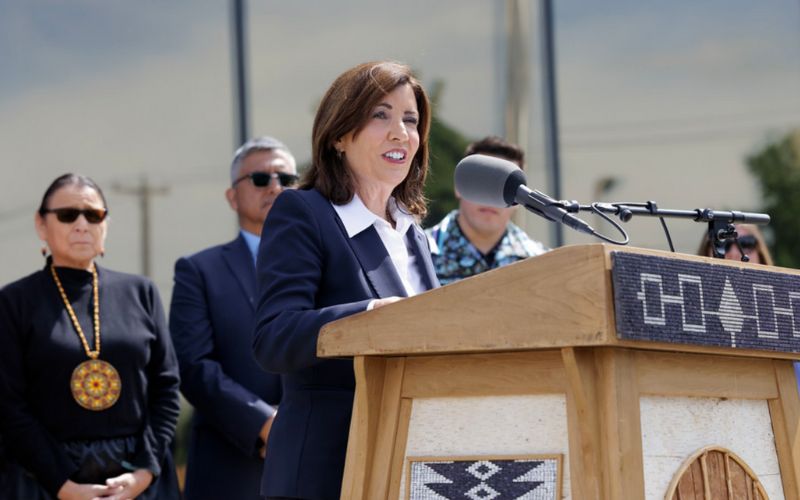
- Details
- By Leslie Logan
Since March, when President J. Conrad Seneca announced the Hochul apology; the Seneca people have expressed their own views on the matter on social media and in public. On the second Saturday in May, at Council, for nearly an hour and a half, Senecas stood up, one after another, and voiced their concerns and opposition to the Hochul visit; one lone voice defended the move.
Two days later, the Seneca Council, executives, and a small group of Senecas travelled to Albany, where Seneca ally and neighbor New York Sen. George Borrello introduced a resolution acknowledging the harm done by the state to the Senecas in the inhumane treatment of its children at Thomas Indian School (TIS). Many Senecas were moved, softened, and appreciative of the stirring speech on the floor of the Senate, as it was received as sincere and meaningful.
But an apology from Gov. Hochul just a week later–that’s far more complicated and harder for many Senecas to stomach. An apology–or a “sorry”–from the same head of state who turned the economic screws to 8,500 Seneca tribal citizens, throwing the Nation into chaos and paralysis a short three years ago is a hard sell.
Once the visit was officially announced at the annual Buffalo Creek Treaty commemoration event on May 16, the Seneca chatter blew up online and across the territories. While reactions have been mixed, the voices that have defended have been outnumbered by those staunchly opposed, with strong words directly aimed at Kathy Hochul. Others have been torn, weighing the good deed of an apology amid the bad taste that still fouls the mouth. Still others expressed doubt and uncertainty about the value and outcome of an apology. On the Seneca Media and Communications Facebook page announcing the visit, three out of 70 comments expressed favorable views of the Hochul apology.
Yesterday, driving onto the site of the event, Seneca marshals stopped cars, asking if drivers had protest signs, apparently prepared to forestall any clamor.
The apology has been framed as a necessary first step towards healing, an overdue acknowledgement for harms done, and a significant measure, perhaps based on hope, towards changing the dynamic in a long-tattered and troubled relationship with the state. President Seneca’s rationale for suggesting the state apology is compelling and valid.
The Seneca Nation urged the apology as a way of supporting the handful of remaining survivors of Thomas Indian School, some of whom suffered lifelong emotional and social impacts from both the abuse and the severing of family and cultural ties. As many residential school survivors from throughout Indian Country have attested, the residual effects have been passed down like an intergenerational genetic code, spreading and spilling over into family lines two generations removed from the harrowing experience.
We all want healing, but can a federal or state apology do that–magically wash away impenetrable pain buried deep in the bone, the blood, and the memory bank of Native people?
Consider Joe Biden’s national apology for the impact of the more than 400 US residential schools on tens of thousands of Native children and descendants. What followed from that apology was a listening tour led by Secretary of the Interior Deb Haaland (Laguna Pueblo) and a report that never used the word genocide to describe the wide-reaching, overt attempt to further remove and destroy Native people by getting at the lives of vulnerable children. A monument is slated at the former Carlisle Indian School to acknowledge the dark past and honor the children. Is a cold marble monument a sufficient salve for healing?
What’s at issue for many Seneca tribal citizens is the apologist, the governor herself, and the perceived value of a Hochul apology; what’s at stake is her sincerity.
In the days leading up to the historic event, there was an attempt to cool the simmering heat bouncing off the cybersphere. “This isn’t political,” said one supporter in a post. “This is about healing.” The first lady of the Seneca Nation reminded the survivors that they were the top priority, that they were consulted, and that this was their moment.
In 2022, I tried to ascertain how many survivors remained. I never got an answer. I asked around again this week and was told only six remained who were residents, and a few more who went to day school at TIS. In its 102 years of operation, 2,740 children, not all Senecas, went to TIS; that means a lot of descendants. It’s likely that the vast majority of Senecas are just one or two degrees removed from some relative who was touched or tortured at TIS.
My maternal grandmother lacked familial connection and had no memories of a loving, caring childhood, as she was in TIS from the age of four until her release at 17. Parents were told they were unable to visit. In all those years, her mother visited her twice. Generational trauma is real.
I reached out to my cousin Wes Sylvester, who went to TIS as a young child. When asked if the apology would provide healing for him, without hesitation, he said, “No. It hurts what they did to us. I ain’t ever going to get over it.”
I spoke with Elliot Tallchief; he and his brother and sister were the last three students to leave TIS when it shut down in 1957. He was separated from his siblings at TIS and after his release. He was one of two residential survivors who attended the private session with the governor today. Would he find healing from the apology? Again, a hard no. “No apology is going to give healing,” said Tallchief. Without any prompt, he said, “This is political, this isn’t for my benefit.”
It is clear that Tallchief, who was taken from his home at 5 years and remained there until he finished high school, has long wrestled with what the school deprived him of: the connection to family, being loved, exposure to culture and language–things that later helped him rebuild his life.
The merit of a Hochul apology is further dubious because many Senecas, unburdened from amnesia, still carry the sting of the 2022 Hochul economic chokehold fresh in their minds.
On April 22, 2022, Hochul froze all of the Nation’s bank accounts after a protracted gaming compact dispute, when the disputed revenue was held securely in an escrow account. At the heart of the dispute was whether the Seneca Nation owed the state more than half a billion dollars in gaming revenue share in the extended period of the Compact, a document in which no language requiring the payments exists.
Within days of Hochul’s freezing of the Nation’s assets, the Senecas relented, unable to make payroll for 4,500 employees, and forked over more than half a billion to the state.
In an article I wrote chronicling the debacle, Ross John, the lone councilor opposed to paying the state, said of Hochul’s strong-arm tactic, “This is economic terrorism, the whole thing smacks of extortion.”
There was a war of words in the press. Hochul played hardball. Hochul held the Nation hostage. Hochul’s husband exacerbated things–high in the ranks of Delaware North, the Seneca’s gaming competition, it appeared man and wife succeeded in cutting into the Seneca’s gaming revenue, all the while whittling away at exclusive market protection guarantees. To the Senecas, it was sinister, smacking of days when the feds and state, in cahoots with land speculators, gamed the Seneca and stole their land in the fraudulent Buffalo Creek treaties.
The loss of Buffalo Creek land, the largest, most inhabited territory at the time, also led to the establishment of the Thomas Indian School. Presbyterian missionaries Asher and Laura Wright took in Seneca children who had lost their parents to devastating disease in the mass move from Buffalo Creek to Cattaraugus. Their efforts led to the establishment of the asylum- the Thomas Asylum for Orphan and Destitute Indian Children, which Seneca “students” mispronounced and called ‘Salem. Today, nearly 200 years later, the Seneca people are still feeling the effects of the Buffalo Creek fraud and Salem.
State distrust and bad faith
The gaming compact expired two and a half years ago. The JC Seneca administration is the third one to try to get the state to the table in good faith to negotiate a new, fair compact.
In August 2023, after months of negotiations, Gov. Hochul reverted to demanding a 25% revenue share. The then-president called it an insult. President Seneca is in his sixth month of a short two-year term and has not met once with the governor to negotiate. The good faith has been difficult to discern when requests to meet have been delayed, denied, and dismissed.
Today, in a press conference, the president talked about how his administration was building a foundation for better relations. He said, “We need to exercise patience. But we’ll get it done.”
To say the Senecas have hard feelings, struggle with trust issues, are still smarting from Hochul’s aggression, and what many Senecas maintain was a half-billion economic injustice is an understatement. Add the ravages of residential schools to the menu of state wrongs, and you have a full table of unsavory contentions.
In 2019, California Gov. Gavin Newsom issued an executive order apologizing to the tribes in his state for the historic violence, abuse, and neglect, acknowledging the attempted genocide of more than 100 tribes. Some tribal leaders acknowledged, but did not accept the apology. Why? Talk is cheap, and leaders want to see action and results.
Read part two of this opinion piece here.
Leslie Logan (Seneca, Cattaraugus Territory) is a freelance writer and consultant, outspoken activist, community organizer, proud mother of two, and descendant of residential school survivors of Thomas Indian School, Quaker Bridge (Tunesassa), and Carlisle.
Help us defend tribal sovereignty.
At Native News Online, our mission is rooted in telling the stories that strengthen sovereignty and uplift Indigenous voices — not just at year’s end, but every single day.
Because of your generosity last year, we were able to keep our reporters on the ground in tribal communities, at national gatherings and in the halls of Congress — covering the issues that matter most to Indian Country: sovereignty, culture, education, health and economic opportunity.
That support sustained us through a tough year in 2025. Now, as we look to the year ahead, we need your help right now to ensure warrior journalism remains strong — reporting that defends tribal sovereignty, amplifies Native truth, and holds power accountable.
 The stakes couldn't be higher. Your support keeps Native voices heard, Native stories told and Native sovereignty defended.
The stakes couldn't be higher. Your support keeps Native voices heard, Native stories told and Native sovereignty defended.
Stand with Warrior Journalism today.
Levi Rickert (Potawatomi), Editor & Publisher

